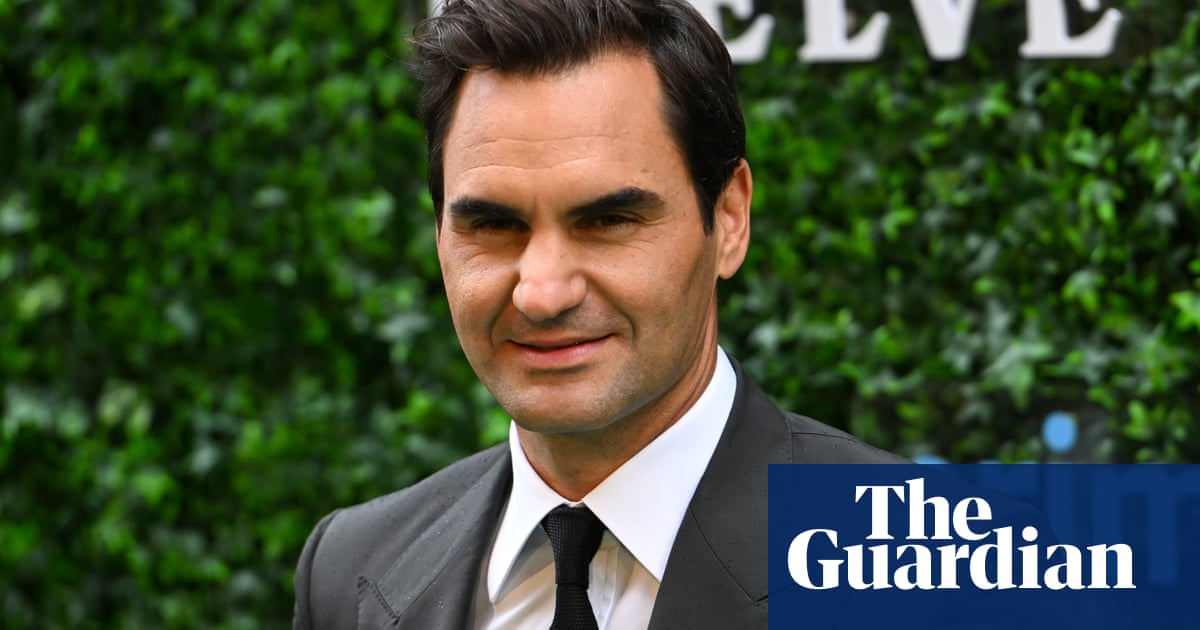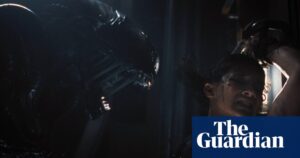
If tennis were a country unto itself, with physical borders and a uniting flag to go with its distinct customs and culture, it would be Roger Federer’s bandanaed profile on the bank notes. For the better part of the past two decades the Swiss maestro has been the closest thing in sport to a true sovereign, one who projected soft power with aristocratic dress and polyglot speech and backed it up with an arsenal of mind-bending on-court majesty that routinely tipped into the divine. Even Federer’s taped retirement message – delivered in September 2022 from his Basel office against a display case that featured a sampling of his 103 career titles – played like a president’s fireside chat.
Still, the significance of that moment might well have been lost on Joe Sabia if he hadn’t lucked into the job of filming it for posterity. “I hadn’t really watched much of Federer when I met him in 2019,” says Sabia, a non-tennis fan who first interviewed Federer for a viral web series he created for Vogue called 73 Questions. “It’s a 15-minute, one-take shoot. There’s a lot of collaboration with the talent. It’s theatrical, hard to pull off – but he did it rather easily, on Wimbledon centre court no less. I was amazed.”
That brief meeting, no doubt arranged by Vogue editor and Federer superfan Anna Wintour, won so much of trust from the eight times Wimbledon champ that his camp wound up reaching out to Sabia three years later to gauge his interest in another opportunity. “They said, ‘Hey, he’s retiring in a couple days. We have no idea if he should be doing video. We feel like we should, but have no idea what it could be.’” Before there was time to second-guess it, Sabia scrambled to Switzerland with director of photography Jess Dunlap to begin filming Federer: Twelve Final Days, a new Prime Video documentary on Federer’s two weeks’ notice.
Sabia co-directed the film, his first ever full-length feature, with Asif Kapadia, the bravura Bafta and Oscar winner behind Senna, Amy and Diego Maradona – all incandescent talents who died tragically. Kapadia jokes that he is counting on this new doc to salvage his reputation for making downer movies, however unfair that accusation is when it comes to Maradona – who, the director hastens to note, was very much still alive when they started filming.
“I was in Naples, which is a very superstitious place, trying to explain myself to someone asking why I – a non-Italian, non-Neapolitan, non-Argentinian – was making this film [on Maradona],” he says. “And I’m like, ‘Well, I did this film about this racing driver (dead) and this famous singer (dead)’ – and you could just see them going, ‘You’re a curse!’
“One of the good things about this film is that there is a death, yeah, but it’s the death of an athlete’s career. They die twice, and this is us covering the first one.”
Sabia conceived and executed most of the film before Kapadia was brought in to help carry it over the line. “We did not meet until the day the film premiered in Tribeca,” Kapadia says. He could have bullied his way into a solo director credit, but it was especially important to Federer for this film to be a breakout for Sabia. “Roger, the entire time, said, ‘I need this for Joe to be at least the co-director on this film because I want this to be a moment for him,” Sabia says. “If he didn’t say that, and Asif didn’t comply, then I probably would’ve gotten steamrolled.”
To the casual observer, Kapadia and Sabia’s film, which combines their exclusive footage with family home videos and match highlights, might seem ordinary – dull, even. This isn’t Kobe Doin’ Work. This is a 40-year-old father of four crying uncle before shuffling off to play in the Laver Cup, an essentially meaningless exhibition tournament, with his three biggest rivals and an assortment of young challengers on the rise; that story could have also been told in 15 minutes rather than 90. But for those of us who have spent the better part of the past two decades over-analyzing everything about Federer (the way he tosses the ball up before serving, his annoying habit of appearing as if he doesn’t sweat, what he’s not telling English-speaking media when he’s addressing other press in Swedish or Swiss-German), Kapadia and Sabia’s doc is far and away the most satisfying morsel of maestro content since David Foster Wallace’s Roger Federer as Religious Experience.
Among the revelations in Twelve Days: we learn Federer messed up his right knee, the joint that precipitated his retirement, while drawing a bath for his kids. We visit with his wife, Mirka, who has said almost nothing to the media for 20 years and inspired Zendaya’s character in the movie Challengers. But here we see a different side of her as she waxes nostalgic on life on tour with four small kids. (“When she said, ‘Yes, I’ll do it,’” Sabia recalls of his sitdown request, “everyone in the room went, ‘Whoa!’”) We see ESPN’s Mary Jo Fernandez helping Tony Godsick, her husband and Federer’s longtime agent, coordinate the PR strategy around the retirement announcement – a scene that is sure to have those who have long accused Fernandez of having conflicted interests screaming, I knew it! “What’s interesting,” Kapadia says, “is no one said, ‘Don’t show it.’”
“Roger wasn’t giving notes on what he wanted in terms of film, or what the fans would see,” adds Sabia. “In a world where every doc needs to be everything for everyone, you have this little oasis that is subtle and stressful and sad, but also contemplative. Just a collection of moments. It’s a special thing.”
We hear Federer offer up sage reflections on his personal rivalry with Novak Djokovic, adding that much of the perceived enmity was whipped up by his fans. But that line becomes a much tougher sell when Djokovic shows up to a London hotel lobby before a fancy Laver Cup dinner, informs his fellow players that they’re all wearing the wrong dress shirt for the occasion – and Federer makes a point of stripping down and changing in front of everyone. “It’s still this kind of weird competition between them of not wanting to look wrong but also this childishness,” Kapadia says, “like kids in a school playground even though they’re guys with private jets.”
Twelve Days could have easily gone the traditional documentary route and taken in the full sweep of Federer’s career – from his super brat beginnings to his era-defining rivalry with Rafael Nadal to the late-stage resurgence that culminated with his sixth Australian Open championship and final grand slam title. A hyper-focused approach allowed Sabia to play to his strengths and remain firmly in the present while creating space for the tennis fans on his production team to fill in tiny textures most important to them: the US Open ballboy who can’t hide his smirk when Federer hits a tweener past Djokovic to win the 2009 US Open semis, not just the video but the sound of Federer’s racquet striking the ball in slow motion. “I’m just grateful that we have a project that doesn’t need to be so amped up, so hyped up,” Sabia says. “It can just be very realistic.”
“I do drama as well as docs,” says Kapadia. “In drama you can make a film about a friendship or a relationship that lasts a day or a weekend. Somehow people have become obsessed with this idea that a doc has to be about everything or else. But I say let’s just enjoy the simplicity of getting in the car, being in the elevator, knowing at some point – and he and everybody around him knows this – that Federer is going to lose control.”
The tension in the Federer doc lies what is still to play out. The closer Federer comes to parting company with Nadal, Djokovic and Murray at the Laver Cup, the more it hits you that this could well be the last time tennis’ big four will compete on court for individual stakes. Repeatedly, Federer says he hopes to keep a hand in the game, but who knows where life takes him and his peers – not least Djokovic, who may well wind up the actual head of state in Serbia someday.
In the fullness of time, Twelve Days only figures to become more resonant once Nadal, Murray and Djokovic start saying their goodbyes and tennis transitions into a country for younger men who are unafraid to rule. “There’s a lot in here,” Kapadia says of his film. “It’s just subtle. And it needs a little bit of thinking about because it’s a small film about big people.”
-
Federer: Twelve Final Days is now streaming on Prime Video.
Source: theguardian.com

















